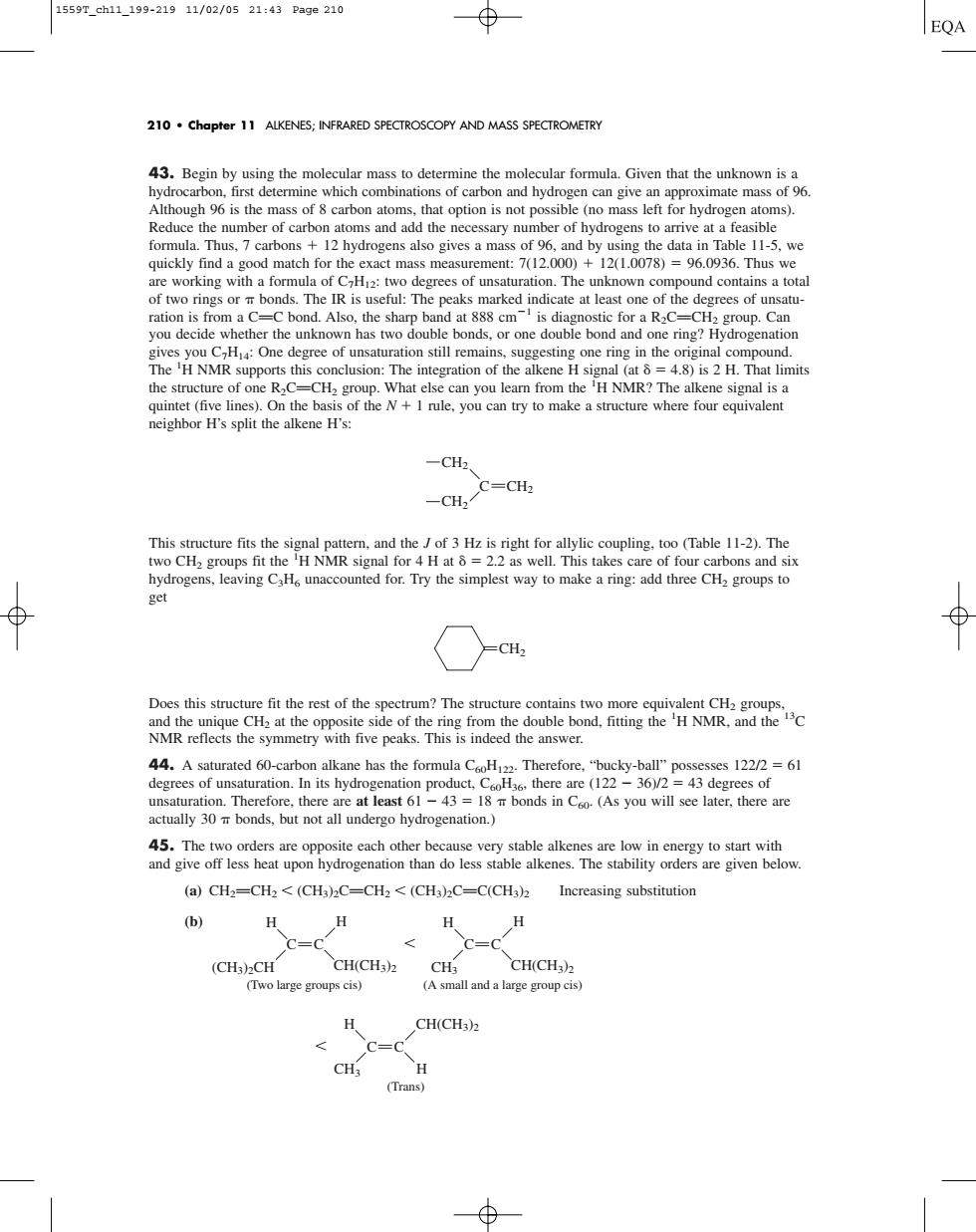正在加载图片...

1559r.eh11.199-21911/02/0521:43Page210 EQA 210.Chapter 11 ALKENES;INFRARED SPECTROSCOPY AND MASS SPECTROMETRY 43.Begin by using the molecular mass to determine Althoug is the mass that opuion is not possibl (left for hyd rogen atoms】) Reduce the number of carbon atoms and add the necessary number of hydrogens to arrive at a feasible tch fo hydrogens also gives a m 026 are working with a formula of Ctwo degrees of unsaturation.The unknown compound contains a total of t wo rings or T bon R is useful:The peaks Iindicate at le one the rees of unsa quintet (five lines).On the bas s of the N+1 rule,you can try to make a structure where four equivalent neighbor H's split the alkene H's -CH2 -CH,C-CHs re fis the22p眼eT2 wo CH groups fit the care get aving CH or 4 H at 8 mplest way to m a ring:a ⊕ CH. Does this s tructure fit the rest of the s m?The structu e CHa at the 44.A saturated 60-carbon alkane has the formula CooH Therefore "" ses122/2=61 degrees of unsaturation.In its hydrog enation product,C there are ( 18 bonds in Co(As you will see later,there are 45.The two orders are opposite each other because very stable alkenes are low in energy to start with and give off less heat upon hydrogenation than do less stable alkenes.The stability orders are given below (a)CH2-CH2<(CHa)2C-CH2<(CHa)2C-C(CH3)2 Increasing substitution (b) H H H CH(CHs)2 (CH) CH: CH(CH) H CH(CH3)2 CH (Trans)43. Begin by using the molecular mass to determine the molecular formula. Given that the unknown is a hydrocarbon, first determine which combinations of carbon and hydrogen can give an approximate mass of 96. Although 96 is the mass of 8 carbon atoms, that option is not possible (no mass left for hydrogen atoms). Reduce the number of carbon atoms and add the necessary number of hydrogens to arrive at a feasible formula. Thus, 7 carbons 12 hydrogens also gives a mass of 96, and by using the data in Table 11-5, we quickly find a good match for the exact mass measurement: 7(12.000) 12(1.0078) 96.0936. Thus we are working with a formula of C7H12: two degrees of unsaturation. The unknown compound contains a total of two rings or bonds. The IR is useful: The peaks marked indicate at least one of the degrees of unsaturation is from a CPC bond. Also, the sharp band at 888 cm1 is diagnostic for a R2CPCH2 group. Can you decide whether the unknown has two double bonds, or one double bond and one ring? Hydrogenation gives you C7H14: One degree of unsaturation still remains, suggesting one ring in the original compound. The 1 H NMR supports this conclusion: The integration of the alkene H signal (at 4.8) is 2 H. That limits the structure of one R2CPCH2 group. What else can you learn from the 1 H NMR? The alkene signal is a quintet (five lines). On the basis of the N 1 rule, you can try to make a structure where four equivalent neighbor H’s split the alkene H’s: This structure fits the signal pattern, and the J of 3 Hz is right for allylic coupling, too (Table 11-2). The two CH2 groups fit the 1 H NMR signal for 4 H at 2.2 as well. This takes care of four carbons and six hydrogens, leaving C3H6 unaccounted for. Try the simplest way to make a ring: add three CH2 groups to get Does this structure fit the rest of the spectrum? The structure contains two more equivalent CH2 groups, and the unique CH2 at the opposite side of the ring from the double bond, fitting the 1 H NMR, and the 13C NMR reflects the symmetry with five peaks. This is indeed the answer. 44. A saturated 60-carbon alkane has the formula C60H122. Therefore, “bucky-ball” possesses 122/2 61 degrees of unsaturation. In its hydrogenation product, C60H36, there are (122 36)/2 43 degrees of unsaturation. Therefore, there are at least 61 43 18 bonds in C60. (As you will see later, there are actually 30 bonds, but not all undergo hydrogenation.) 45. The two orders are opposite each other because very stable alkenes are low in energy to start with and give off less heat upon hydrogenation than do less stable alkenes. The stability orders are given below. (a) CH2PCH2 (CH3)2CPCH2 (CH3)2CPC(CH3)2 Increasing substitution (b) H (Two large groups cis) (A small and a large group cis) H C C (CH3)2CH CH(CH3)2 H H C C CH3 CH(CH3)2 (Trans) H H C C CH3 CH(CH3)2 CH2 CH2 C CH2 CH2 210 • Chapter 11 ALKENES; INFRARED SPECTROSCOPY AND MASS SPECTROMETRY 1559T_ch11_199-219 11/02/05 21:43 Page 210���